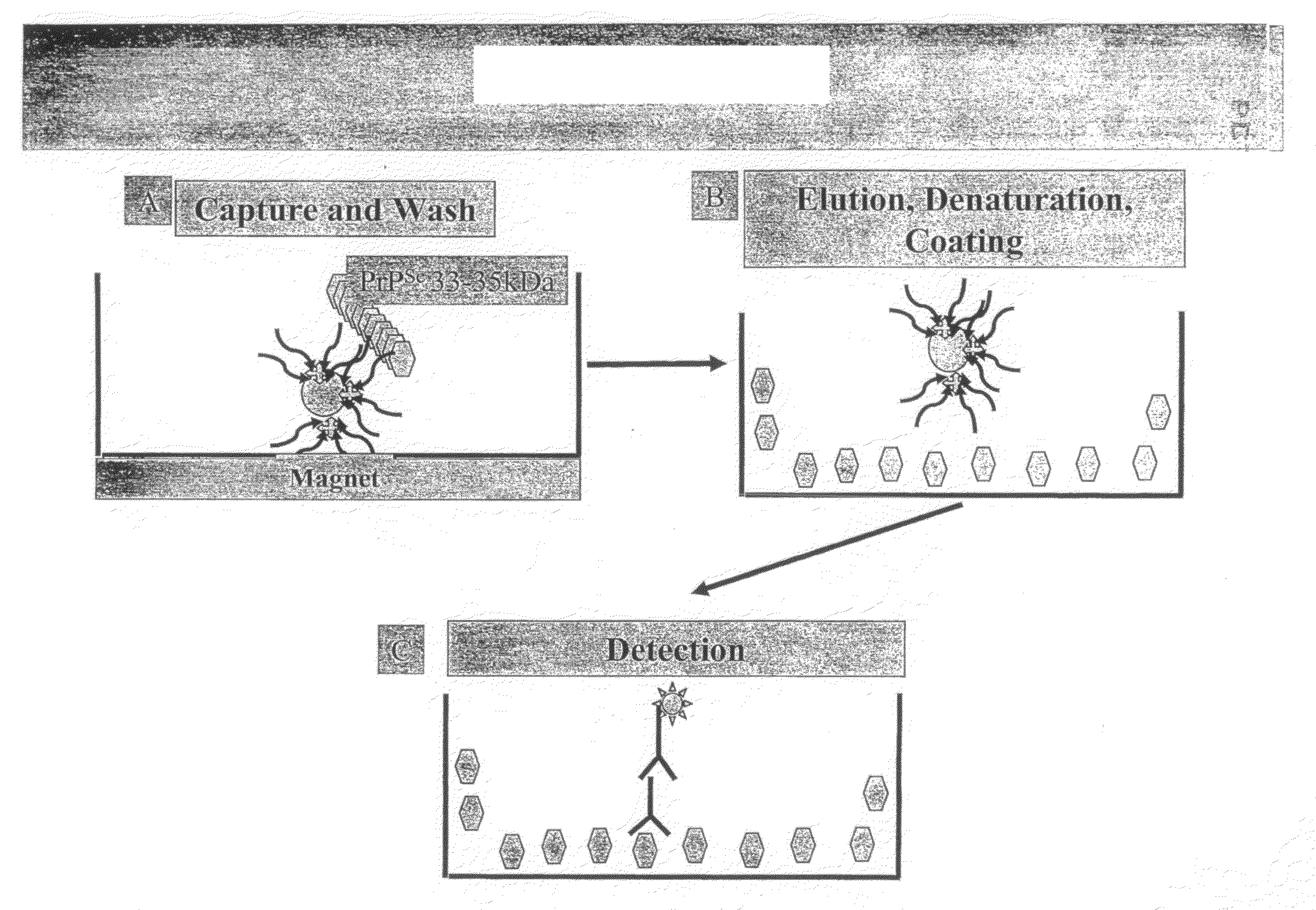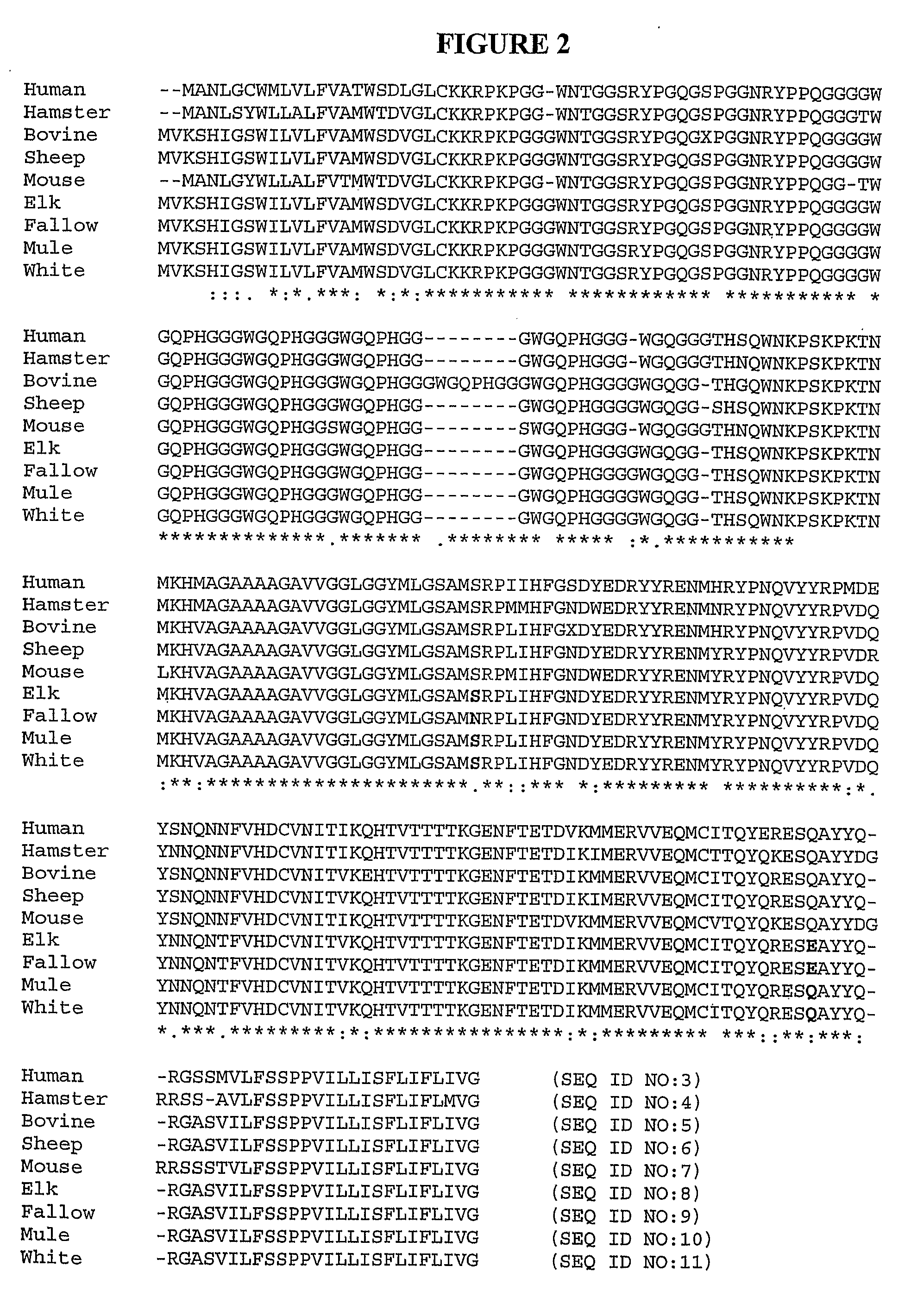Elisa assays using prion-specific peptide reagents
a technology of prion-specific peptides and assays, applied in the field of peptide reagents, can solve the problems of unmet definitive diagnosis and palliative treatment of amyloid-containing conditions before the subject's death, risky histopathological examination of brain biopsies, and difficult detection of conformational disease proteins in living subjects and samples obtained from living subjects
- Summary
- Abstract
- Description
- Claims
- Application Information
AI Technical Summary
Benefits of technology
Problems solved by technology
Method used
Image
Examples
example 1
Peptide Reagent Production
[0226]Peptide fragments of prion proteins were chemically synthesized using standard peptide synthesis techniques, essentially as described in Merrifield (1969) Advan. Enzymol. 32: 221 and Holm and Medal (1989), Multiple column peptide synthesis, p. 208E, Bayer and G. Jung (ed.), Peptides 1988, Walter de Gruyter & Co. Berlin-N.Y. Peptides were purified by HPLC and sequence verified by mass spectroscopy.
[0227]In certain cases, the peptides synthesized included additional residues at the N or C terminus, for example GGG residues and / or included one or more amino acid substitutions as compared to wild-type sequences.
A. Peptoid Substitutions
[0228]Peptoid substitutions were also made in the peptide presented in SEQ ID NO:14 (QWNKPSKPKTN, corresponding to residues 97 to 107 of SEQ BD NO:2), SEQ ID NO:67 (KKRPKPGGWNTGG, corresponding to residues 23-36 of SEQ ID NO:2) and SEQ ID NO:68 (KKRPKPGG, corresponding to residues 23-30 of SEQ ID NO:2). In particular, one or...
example 2
Binding Assays
A. Pull-Down
[0233]Peptide reagents as described herein were tested for their ability to specifically bind to prion proteins using a magnetic bead pull down assay. For this assay, the peptide reagents were either labeled with biotin, which allowed attachment to streptavidin coated magnetic beads or were covalently attached to magnetic beads.
[0234]Brain homogenates are prepared from RML PrPSc+ and PrPC+ Balb-c mice. In brief, 5 mL of TBS buffer (50 mM Tris-HCl pH 7.5 and 37.5 mM NaCl) with 1% TW20 and 1% triton 100 was added to brains weighing ˜0.5 g to produce a 10% homogenate. The brain slurry was dounced until large particles had disappeared. Aliquots of 200 μl were diluted 1:1 in buffer were added to pre-cooled eppendorf tubes and the samples sonicated for several repeats of several seconds each. Samples were centrifuged for 10-15 minutes at. 500× and the supernatants removed.
[0235]To test the effect of Proteinase K digestion, certain supernatants were divided into t...
experiment 3
Sandwich ELISA and pH Dissociation
[0257]Chaotropic agents like guanidinium salts are effective for dissociation of the PrPSc captured in the pull-down step and denaturation as shown in example 2. However, the guanidinium must be removed or significantly diluted in order to expose the denatured prion protein to anti-prion antibodies (that are used e.g., for detection of the PrP). This is not problematic for direct or indirect ELISA (in which the PrP is coated directly on the microtiter plate in a fairly large volume) but can be a problem for Sandwich ELISA. We have developed an alternative protocol for denaturation of the captured PrPSC from the peptide reagent that does not use Gdn and does not require additional washes or introduction of large volumes for dilution. This method uses a pH treatment, at either high pH or low pH, for denaturation of the PrPSC. The denatured PrP dissociates from the peptide reagent. The denaturing conditions can be easily removed by neutralizing the sol...
PUM
 Login to View More
Login to View More Abstract
Description
Claims
Application Information
 Login to View More
Login to View More - R&D
- Intellectual Property
- Life Sciences
- Materials
- Tech Scout
- Unparalleled Data Quality
- Higher Quality Content
- 60% Fewer Hallucinations
Browse by: Latest US Patents, China's latest patents, Technical Efficacy Thesaurus, Application Domain, Technology Topic, Popular Technical Reports.
© 2025 PatSnap. All rights reserved.Legal|Privacy policy|Modern Slavery Act Transparency Statement|Sitemap|About US| Contact US: help@patsnap.com



